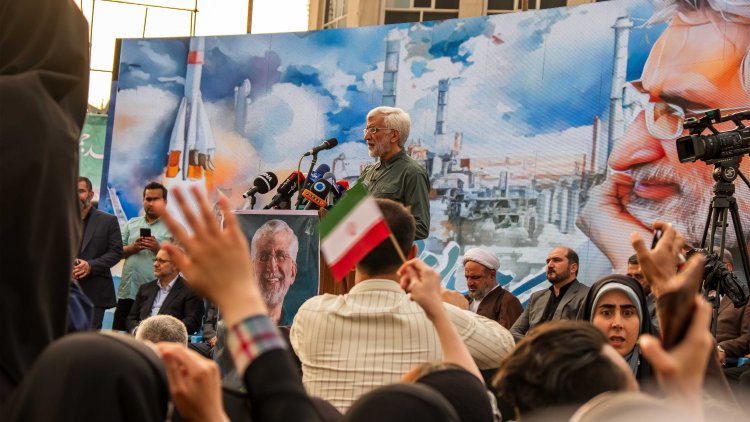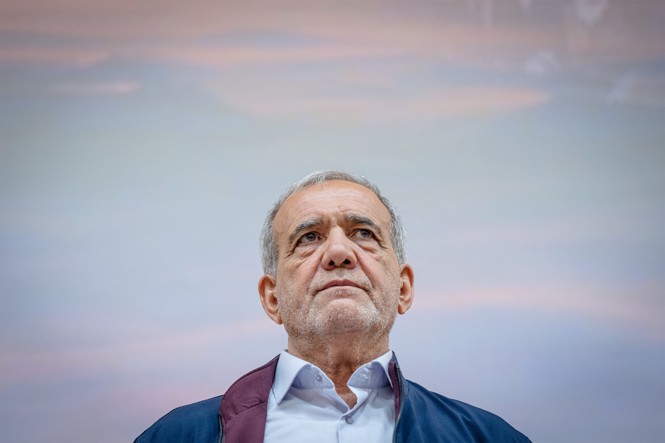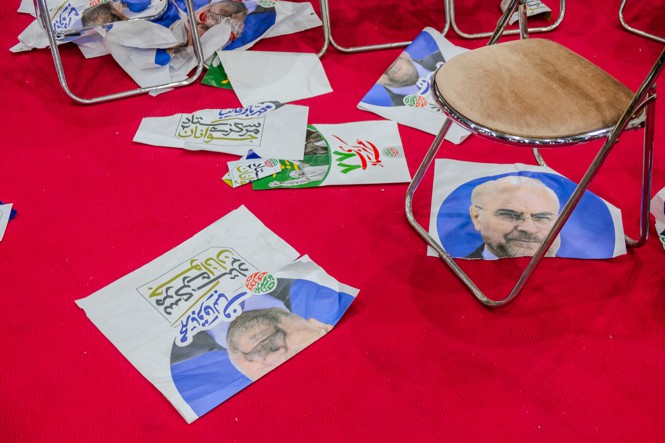In Iran, the Big Winner Is None of the Above
A second round between an extremist and a reformist will put the logic of boycott to the test.

Since the death in May of President Ebrahim Raisi, Iran has been in the throes of a surprise electoral contest. Not for the first time, one of the loudest campaigns has belonged not to any of the candidates, but to opponents of the regime who advocate boycotting the vote. Among those who refused to vote on June 28 were the Nobel Peace Prize laureates Shirin Ebadi and Narges Mohammadi, the labor leader Esmayil Bakhshi, former Prime Minister Mirhossein Mousavi (under house arrest since 2011 for leading the Green Movement protests), and Mostafa Tajzadeh, a prominent reformist turned critic who is in prison.
Now the first-round results are in, and they suggest a grand victory for the boycotters. On election day, so few Iranians came out to vote by 6 p.m., when the polls were due to close, that the regime extended voting hours all the way to midnight (the legal maximum). And yet, even if the interior ministry’s numbers are to be believed, turnout climbed no higher than 39.9 percent, by far the lowest in the history of the Islamic Republic.
[Read: Who would benefit from Ebrahim Raisi’s death?]
The previous presidential election, in 2021, was much less competitive—effectively a coronation for Raisi—and turnout was 49.9 percent. This time around, not even the inclusion of a reformist candidate, Masud Pezeshkian, who had the full support of once-popular former Presidents Mohammad Khatami and Hassan Rouhani, brought voters to the polls. Nor did the tireless campaigning of former Foreign Minister Javad Zarif. The Iranian regime urges its supporters to vote as an act of fealty to the Islamic Republic, so refusing to vote is traditionally understood as an expression of dissent against the regime and its policies. And the message this year is clear: In the first presidential election since the Women, Life, Freedom protests of 2022–23, the majority of Iranians are making clear with their voting behavior, just as they did in the streets, that they reject the Islamic Republic.
And so one might expect that the reformist candidate, who would have been the likeliest choice for those who stayed home, would have been the biggest loser. It has long been held axiomatic in Iran that low voter turnout will deliver a victory to the hard-liners. But Pezeshkian surprised many by topping the poll on Friday with 42.5 percent of the vote, which sends him to a runoff, to be held on July 5, against Saeed Jalili, a fundamentalist hard-liner who came away with 38.6 percent. To many critics of the regime, even some of those who voted for Pezeshkian, the outcome was ideal: an expression of mass dissatisfaction that still managed to put a reformist in the lead.
The biggest loser on Friday was in fact Mohammad Baqer Qalibaf, the wily speaker of Parliament and a former commander of the Islamic Revolutionary Guards Corps (IRGC), a militia that wields great economic and military power in Iran. Running on a technocratic agenda, the conservative Qalibaf had started the race as the presumed front-runner, hoping to appeal to both hard-line voters and those more critical of the regime. Ultimately, he pleased neither quarter, lost both, and received just 13.8 percent of the vote. The result is an embarrassment not only for Qalibaf but also for the IRGC. The militia’s media outlets supported Qalibaf, but much of its rank-and-file clearly preferred the out-and-out extremist, Jalili. Qalibaf has dutifully endorsed Jalili, even though his campaign attacked Jalili for weeks, and his agenda is in many ways closer to Pezeshkian’s.
Opponents of the regime can celebrate Friday’s low turnout as proof that most Iranians share their disgust with the entire system and do not wish to legitimize it with their vote. But now they face a dilemma. Should they boycott the second round on July 5 and allow Jalili to cruise into the presidency? Or should they cast a lesser-evil vote for the reformist Pezeshkian?
Jalili’s extremism can’t be overstated. Many conservatives concede that Iran needs to engage in talks with the West to lessen the pressure of sanctions. But Jalili leads a hard-core faction that believes Iran should mostly give up on the West. His grand foreign-policy idea during the presidential debates was selling vegetables to Russia. When he led Iran’s nuclear negotiations from 2007 to 2013, his obdurate refusal to observe the most basic norms of diplomatic talks led to stalemate. A European diplomat recently recalled to me that Jalili once spent an important meeting delivering an interminable lecture about the subject of his Ph.D. dissertation, the Prophet Mohammad’s diplomatic engagements in the seventh century. Iran is on a blacklist, held by the Paris-based Financial Action Task Force, that severely limits its international trade not just with Western countries but also with China; Jalili, even according to IRGC media outlets, has used his considerable influence behind the scenes to prevent Iran from taking the transparency measures that would allow it to come off that list, where its only remaining company consists of North Korea and Myanmar.

Jalili’s domestic agenda also reeks of fundamentalism. Amirhossein Sabeti, a rising young member of Parliament and a close Jalili-campaign adviser, recently said that the security forces should attack women who refuse to abide by the compulsory veiling rules “like a war on drugs, harshly and without exception.” Sabeti has also asked for further restrictions on the internet and a crackdown on VPN technology that allows Iranians to circumvent the ban on popular apps such as WhatsApp and Instagram. Another Jalili supporter has advocated capital punishment for those selling VPN software.
[Read: Even the Iranian election is about Trump]
Pezeshkian’s campaign and others who oppose Jalili have begun sounding alarms. On Sunday, a centrist outlet predicted that a Jalili presidency would be “politically like North Korea and culturally like the Taliban’s Afghanistan.” Pezeshkian supporters, such as former Communications Minister Javad Azari-Jahromi, have used similar rhetoric. But a negative campaign won’t be enough to overcome the deep skepticism the reformists face. Pezeshkian doesn’t have firm positions of his own to point to on issues such as the mandatory hijab. And many Iranians feel that Supreme Leader Ali Khamenei, together with unelected bodies, controls all political outcomes to a degree that makes voting for Pezeshkian fruitless, especially when doing so means increasing the turnout.
Amirhossein Mosalla, a reformist activist, told me he would boycott the second round just as he did the first.
“I won’t vote,” he said on Sunday, “because Jalili’s thinking is already being implemented and Pezeshkian has offered no strategy to counter unelected institutions such as the Guardian Council or the hard-liner-dominated Parliament.”
Some critics of the regime go further: Embracing a version of accelerationism, they argue that a Jalili presidency is ultimately better for the opposition, because the regime will grow ever more isolated and thus more prone to being overthrown.
For those of us with a longer historical memory, the July 5 election is eerily reminiscent of another contest held 19 years ago.
In 2005, a young hard-line mayor of Tehran, Mahmoud Ahmadinejad, surprised many by getting more votes than the main conservative candidate, Qalibaf, and making it to the runoff. There he faced Ayatollah Akbar Hashemi Rafsanjani, a centrist regime stalwart. Many reformists, and others in Iran’s civil society, urged their constituents to vote for Rafsanjani in order to vanquish Ahmadinejad, calling it an attempt to “defeat fascism.” They likened the contest to the 2002 elections in France, where the left supported the center-right Jacques Chirac to defeat the far-right candidate in the second round. I remember Hossein Masoumi Hamedani, an intellectual and a literature professor, pleading with me to vote for Rafsanjani, when I was a 17-year-old leftist who would have none of it. (The voting age in Iran was 15 at the time.) Why vote for Rafsanjani, I responded, who would help prolong the regime, when Ahmadinejad could help “heighten the contradictions”?
Many young people followed this logic. And Ahmadinejad did win that year, and he did make Iran ever more isolated, sanctioned, and crisis-ridden. But this didn’t lead to democratization or regime collapse. Rather, the political repression and economic malaise got worse and worse; Rafsanjani’s political defeat gave more power to Khamenei and the hard-liners, not to the democratic movement.
Perhaps I’ve mellowed with age, but I now wish we had supported Rafsanjani back in 2005. At 76, Hamedani is calling for a vote for Pezeshkian, and he now makes more sense to me. The thought of a President Jalili holding any power at this crucial juncture in Iranian history scares me—especially when we remember that he could shape the outcome of the succession crisis that is sure to break when the 85-year-old Khamenei finally dies.
What's Your Reaction?




















